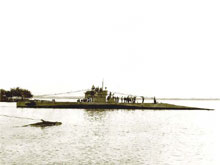Remote-Sensing Survey for the Remains of the Submarine USS O-9 (SS-70)
September 2004
Rick Yorczyk
Archaeological Program Analyst
NOAA Office of Ocean Exploration
In September 2004, a high-tech, maritime archaeology expedition hopes to shed some light on what happened the morning of June 20, 1941 off the Isle of Shoals, New Hampshire to cause the American submarine USS O-9 to sink, taking the lives of all 33 crewmen. This expedition will be carried out with the Marine Sciences Program of the University of Connecticut research vessel Connecticut, and in collaboration with the National Oceanic and Atmospheric Administration (NOAA) Office of Ocean Exploration, the states of Maryland, Massachusetts, and New Hampshire, and the History Channel.
One of 16 O-class submarines, O-9 (hull number later designated as SS-70) was launched on January 27, 1918 at the Fore River Shipbuilding Co., in Quincy, Massachusetts. After several months patrolling the eastern seaboard, O-9 sailed for Britain to begin war patrols, but World War I ended November 11, 1918, before O-9 arrived in European waters. After post-war service, which included training operations and patrols guarding the Panama Canal, O-9 was decommissioned in 1931.

Side-scan sonar image of the remains of the submarine USS O-9 (SS-70) off the Isle of Shoals, New Hampshire in more than 400 feet of water. Click image for larger view and image credit.
With a new world war impending, O-9 was re-commissioned on April 14, 1941 to help train the Navy’s growing number of submariners. Two months later the crew of the USS O-9 was on a training mission and while conducting a deep submergence test, O-9, an old boat built for another war, failed to surface. All efforts to contact the sub were unsuccessful. By evening, telltale debris and an oil slick confirmed the worst. Just why the submarine sank taking the lives of all hands is still unknown. O-9 was operating in the same area in which two years previously the submarine USS Squalus (SS-192) was lost, but 33 crewmen were saved through a remarkable undersea rescue. Because O-9 was in more than 400 feet of water, twice the depth where Squalus sank, rescue was not a realistic option. Several ships searched in a vain attempt at rescue and Navy divers heroically dove to record depths in hopes of at locating the sub, but had to call off the operation because of the great risk.
The precise location of O-9’s final resting also remained unknown, until September 20, 1997. Glen Reem, a retired U.S. Navy Captain, scuba diver, and nautical researcher, assisted by Klein Associates Inc., the maker of side-scan sonar equipment, led a search for O-9 and found it. Sonar images revealed O-9 lying on its side on the ocean floor. Aft of the conning tower, the submarine appeared to be crushed but the forward portion seemed to be intact.
In September, researchers and marine archaeologists will return to the site with a side-scan sonar and remotely operated vehicle (ROV) to conduct a “look but don’t touch” video survey of O-9’s physical condition of the vessel and possibly answer the question as to why it was lost. Because the O-9 wreck is in essence a maritime grave site, the expedition will treat the site with dignity and respect. No objects will be removed from the wreck site. With the assistance of the NOAA Office of Ocean Exploration, Dr. Susan Langley from the State of Maryland will serve as an archaeological lead, and will provide any final site documentation and expedition results to the Naval Historical Center for formal review.


